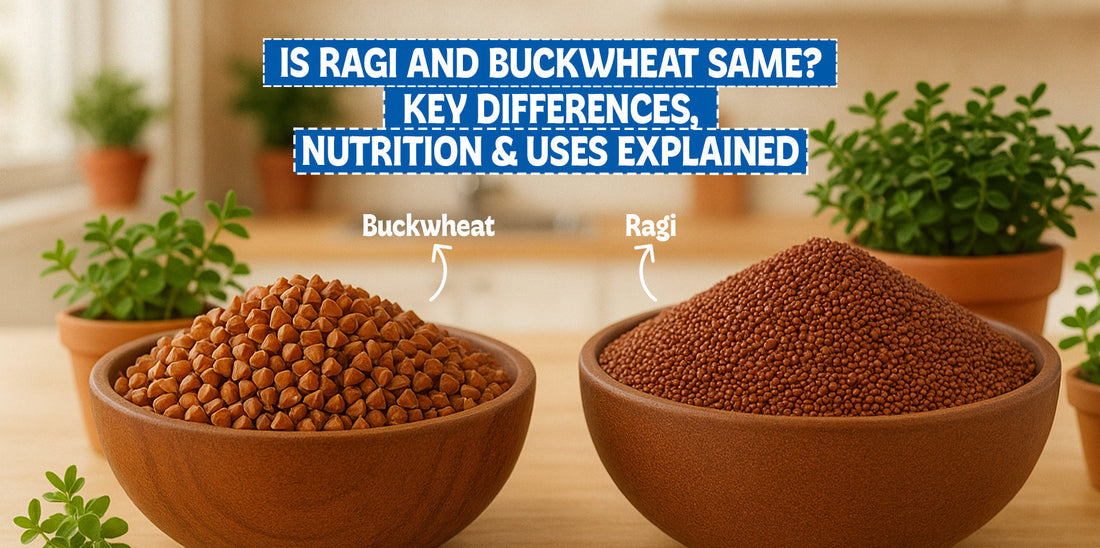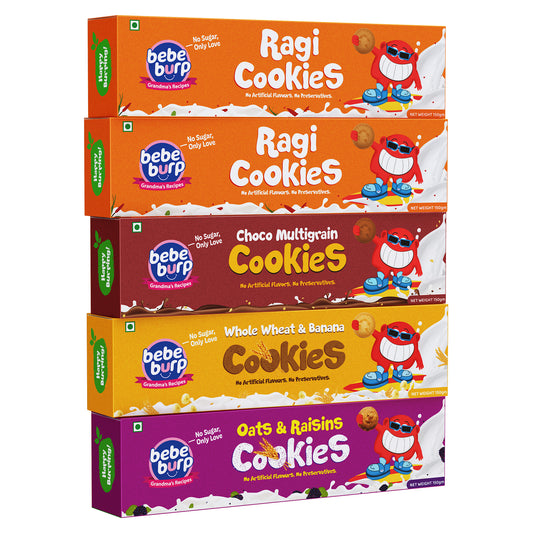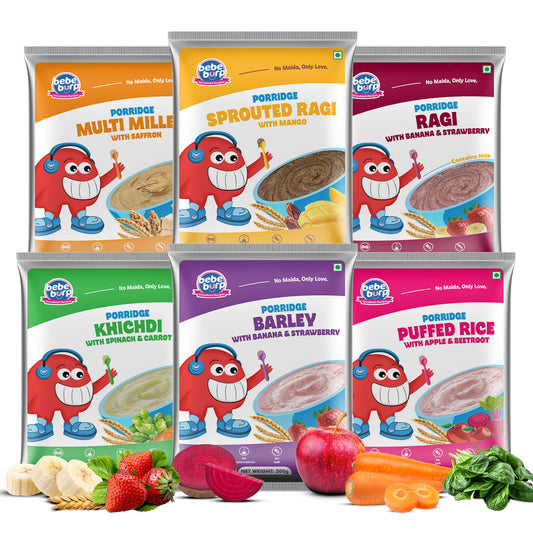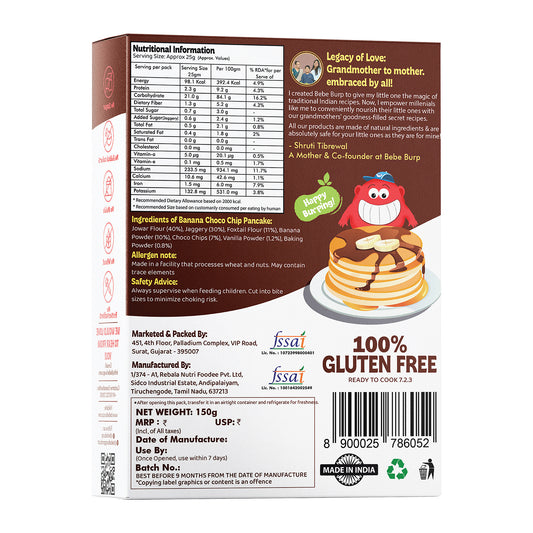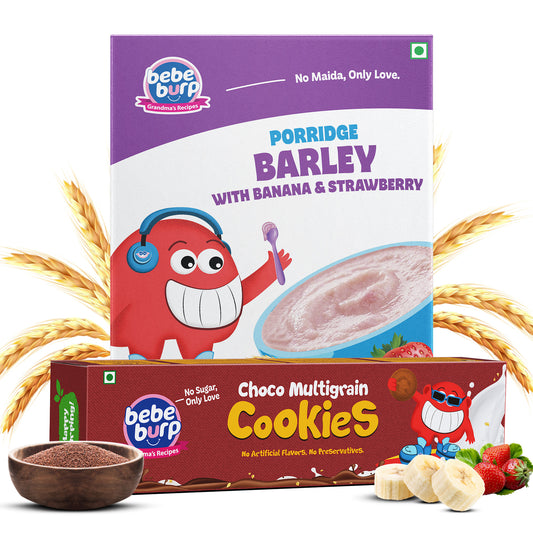No, Ragi and Buckwheat do not mean the same. They are easily confused because they are used in similar ways in gluten-free cooking and baby friendly cooking, although they are botanically and nutritionally unrelated.
What is Ragi (Finger Millet)?
Finger Millet or Ragi, as it is also called, is a small grained whole grain which has been a part of the Indian diet over the last several centuries.
It contains No gluten, is very rich in calcium, iron, and dietary fiber; thus, it is recommended to the baby, kid, as well as adults.
Ragi is particularly common in southern India where it is made into porridge (ragi malt), dosa, idli, and roti.
It is sweet in taste and nutty, and it is an efficient resource in enhancing bones, digestion process and a source of endurance energy.
What is Buckwheat (Kuttu)?
Buckwheat is or locally referred to as Kuttu in India but despite it being regarded as a grain, it is also a seed, which has been used in the same manner.
It contains no gluten, it is a protein, fiber, and significant minerals such as magnesium- and antioxidant-rich food.
Buckwheat is very popular in India to be eaten on the fasting days (such as Navratri) in roti or pakoras made of kuttu flour.
It is not connected to wheat, not even to the gluten intolerant people as indicated in its name.
Ragi vs Buckwheat: Botanical Differences
|
Feature |
Ragi (Finger Millet) |
Buckwheat (Kuttu) |
|
Scientific Name |
Eleusine coracana |
Fagopyrum esculentum |
|
Plant Family |
Poaceae (Grass family) |
Polygonaceae (Knotweed family) |
|
Plant Type |
Cereal grain (true grass) |
Pseudocereal (not a true grain) |
|
Seed Structure |
Small, round grains |
Triangular-shaped seeds |
|
Origin |
Native to Africa, widely grown in India |
Native to Central Asia and Tibet |
|
Growth Habit |
Grows like typical grass with tall stalks |
Broad-leafed plant, looks more like a vegetable than a grain |
|
Relation to Gluten |
Naturally gluten-free |
Naturally gluten-free |
Nutritional Comparison: Ragi vs Buckwheat
Ragi and Buckwheat are gluten-free superfoods that is power-packed, yet they have a slight variation in the nutritional value. These are their comparison in the main nutrients:
1. Protein
- Protein content of Buckwheat is also greater than ragi. It is a complete protein, as it comprises all 9 essential amino acids, which is not very common in plant foods.
- Ragi contains moderate protein, and it is something good on a vegetarian diet and also in growing children who need to build up their muscles.
2. Calcium
- Ragi contains a very high amount of calcium, which is among the highest in grains. This helps to make it good to the bones especially among babies, kids and even pregnant women.
- Buckwheat has a lot less calcium relative to it.
3. Iron
- Both are a good source of iron yet ragi possesses a little high amount of iron, which can help in prevention of anemia and helps in increasing energy levels.
4. Fiber
- Buckwheat is more fibrous, thus helping in digestion, regulating blood sugar and making one feel fuller longer.
- Ragi too possesses good dietary fibers but it is more credible as cooling agent and easy to digestive.
5. Carbohydrates
- Ragi contains more complex carbs and gives a fantastic sustained energy therefore it is suitable in babies and athletes.
- Buckwheat is low carb, with a low glycemic index which is good in diabetic people or people who are weight conscious.
6. Micronutrients
- Buckwheat contains a lot of magnesium, copper, manganese, and antioxidants such as rutin, which benefit the heart.
- Ragi contains high levels of calcium, potassium and iron, and some form of polyphenol which is good with regard to the control of blood sugar level.
Health Benefits of Ragi and Buckwheat
Health Benefits of Ragi (Finger Millet)
Ragi is the invisible straight-laced leader of the nutritional studies- modest, seemingly under-rated and such prolific potential.
- Bone Health Booster: Ragi is among the most calcium-rich sources of the same and is of vegetable type. It benefits bones and prevents osteoporosis and even helps in skeletal development of children-- in other words, it is the vegetal relative of dairy.
- Iron-Rich Goodness: Ragi is also especially good in people concerned with iron-deficiency anemia e.g. women and children. Combine it with the sources of vitamin C such as lemon or amla and you get yourself a nutrient party.
- Healthy Diet: Ragi is highly fibrous and less on the fat front so it will not just leave you feeling more satiated for longer durations of time but you will also not feel so driven to go and open the refrigerator in the middle of night.
- Diabetes friendly: The low GI (glycemic index) and high polyphenol levels of ragi make it a good bet in control of the blood sugar levels. Hooray for diabetics, now you can have your conscience-laden carb!
- Gluten-Free & Gut Friendly: The ragi food source is naturally free of gluten, which acts as stomach friendly food to those with a sensitive stomach.
Health Benefits of Buckwheat (Kuttu)
Buckwheat is the intellectual of misunderstood reputations- it looks like a grain, acts like a seed and it has an antioxidant cape.
- Comprehensive Amyloidosis Powerhouse: Most plant-based foods lack at least one of the so-called essential amino acids compared to buckwheat; they contain all nine. It is the Beyonce of the plant proteins.
- Heart Health Champion: Buckwheat is a good source of rutin, the antioxidant, which promotes blood circulation and brings down bad cholesterol and does even have the ability to speak sweet nothings to the arteries.
- Blood Sugar Stabilizer: Buckwheat is low on the glycemic index and can ensure a stable balance of blood sugar levels the blood, which is why it is good to consume when one is diabetic as well as seeking to avoid sugar spikes.
- Digestive Health: Buckwheat is loaded with insoluble fiber to keep your bowel regular and keeps the good bacteria on your side. Your colon will write thank-you notes to you.
- Boosts Immunity: Buckwheat is a rich source of magnesium, zinc, and manganese; these nutrients will help to boost your immunity and improve metabolic rates; it is as though you are taking your immune system on a wellness spa.
Culinary Uses and Cooking Methods
You might think that Ragi and Buckwheat are simple; however, they are real jack-of-all-trades in the kitchen. The following is the way in which each one of them is usually used and prepared in everyday food:
How Ragi is Used in Cooking
Ragi comes in the form of flour and it is most popular in the Indian families- particularly, the babies and the families that consider it health-friendly.
- It is usually prepared as porridge or ragi malt- simply combine ragi flour with milk or water and sweeten with jaggery or fruits to get all-natural sweetness. It would be ideal on babies (and breakfast).
- The ragi roti, dosa and idli are very popular in South India. These are spicy food with which chutney or sambhar can be consumed.
- Baking, i.e. cookies, pancakes or even cakes also use Ragi. It provides a dependency flavor and makes a superb alternative of wheat flour.
- It can be roasted in ghee and sweeteners and moulded to make laddoo or prepared as ragi halwa to serve as festive foods.
Pro tip: Ragi flour has a tendency to dry up fast. At all times knead with warm water, and a little after.
How Buckwheat (Kuttu) is Used in Cooking
Buckwheat or kuttu is a common food item to follow fast (vrat) in India but is also famous worldwide as a form of gluten-free grain substitute.
- The most widely spread Indian foods are kuttu ki roti or paratha to be generally combined together with a boiled potato as a binding paste.
- Buckwheat pakoras (fritters) are also popular during Navratri i.e. rock salt, spices and veggies are used.
- It also does well for cheelas or pancakes savoury or sweet, they all can be done with simple ingredients.
- In case you have buckwheat groats (the full seeds), you can cook them in a boiled rice style and cook them in salads, soups, or grain bowls.
- The use of buckwheat is popular worldwide, particularly in such dishes as soba, noodle (Japan) or blinchiki (Russian pancakes).
Tip: Buckwheat flour may be crumbly. Mix it with something sticking as mashed potatoes or arrowroot in order to obtain smooth dough
Taste and Texture Differences: Ragi vs Buckwheat
Both Ragi and Buckwheat are gluten-free and healthy, yet they differ considerably in terms of their taste and texture which may influence the choice of its application in the kitchen and the liking or not of people.
Ragi – Earthy and Soft
Ragi (finger millet) tastes mild, earthy and slightly nutty. It is not very strong, and this is why it is the best to prepare some dishes with other ingredients in cakes and savory meals. When cooked:
- It is also smooth and creamy when compose of porridge, perfect as a meal to babies and light-breakfasts.
- Being served as roti or dosa, it is soft in texture with a slight chewiness and becomes soft once hot off the pan.
- It creates a moist effect and density in baked goods. You will find that it gives outdoor freshness and grainy taste.
In general, ragi is gentle and is relatively easy to digest, which can be a comforting ingredient, particularly to little children, older folks or other people with decent digestion.
Buckwheat – Nutty and Grainy
Buckwheat (kuttu) is more tasty, stronger, slightly bitter in taste with higher nutty hint- you love it or learn to combine with lighter flavors.
- When eaten as part of rotis or pakoras there is a slightly grainy crumbly texture, unless potato or water chestnut flour, which acts as binding agent, is added.
- Whole groats cooked in pure water are tender but cooked, so to speak, like cooked quinoa or brown rice.
- In pan cakes or cheelas, it provides robust and substantial bite and has a rustic tasting flavor.
Due to a daring flavor, buckwheat in contemporary cuisine goes with potatoes, yogurt, or sweeteners such as honey and a banana.
Cost and Availability Comparison
Though both Ragi and Buckwheat are healthy and also gluten-free substitutes to wheat, there is a big difference between the two regarding the price and the ease of availability, particularly in the Indian markets.
Ragi – Budget-Friendly and Easily Available
Ragi is a very cheap millet in India. It is spread in large mass in the sties of the south such as Karnataka and Tamil Nadu and this factor makes it readily found and affordable.
- Ragi flour, whole grains, or even ragi food snacks are almost everywhere in local grocery, supermarket, or online market places.
- Several varieties of ragi are easily available under trusted brand like Bebe Burp (which also offers baby-friendly ragi snacks and porridges), and many local millers.
- It is so widespread in baby food and more conventional diets that it is even sold in babies products stores.
Pricing (by 2025):
The flour cost 40-80 per 500g depending on the brand and organic or normal.
Buckwheat (Kuttu) – Seasonal and Slightly Expensive
In India, the use of buckwheat, known as kuttu, is more seasonal and it is mainly a fasting food during Navratri. It is not as popular at all times of the year and hence a little costly and inconsistent in the supply.
- Kuttu flour is used during festivals mainly in typical grocery stores, but whole groats are most likely to be found online or in health institutions.
- It is more popular in metropolitan health-conscious stores, and controlling diets in gluten-free, vegan or high-protein diets.
- It can be even more expensive when it is imported or organic varieties.
Price Range (as of 2025):
₹90–₹150 per 500g (flour); Whole buckwheat groats may cost ₹200+ depending on origin.
Which is Better: Ragi or Buckwheat?
It definitely does not have a one-size-fits-all answer, as they are all genuinely healthy ingredients, with each of them having its own advantages. It will be better to choose depending on your health desires, taste and dietary requirements.
Ragi is Better If You Want:
- More calcium - Great to maintain the health of bones, particularly that of the babies, growing children, pregnant mothers or the aged.
- A low-cost, light and easy to digest grain which is just ideal to be used in Indian everyday meals.
- A soft food, well adapted to baby food, or weak stomachs, or porridge.
- An iron and complex carbs source which creates sustainable energy.
Suited to: babies, toddlers, women, vegetarians, people who need better calcium and iron.
Buckwheat is Better If You Want:
- Greater protein, containing all essential amino acids--excellent muscle repair and non meat diets.
- The Food is of low glycemic index with the help of which it will be able to control the blood sugar levels.
- A fiber and antioxidant-packed food, such as rutin, that helps the heart and the digestive system.
- Something one could eat during fasting (vrat) or a gluten free diet with strong, nutty tastes.
Suitable: diabetes patients, fitness-oriented people, gluten-sensitive people, or people on the fast.
Final Verdict: Include Both If Possible!
If you're building a healthy, balanced diet—you don’t need to choose just one.
-
Use ragi for daily meals, porridges, and baby food.
- Use buckwheat for variety, protein-rich meals, or fasting days.
Common Misconceptions About Ragi and Buckwheat
Although they are traditional Indian staples and superfoods in the modern environment, Ragi and Buckwheat are often misinterpreted. It is time to make some sense of these two powerhouse grains (or rather, one of them is not a grain at all!).
1. "Ragi and Buckwheat are the Same Thing"
It is a fact: They are not botanically alike.
- Ragi is an actual cereal grass which belongs to grass family.
- The knotweed is a pseudo cereal seed that is referred to as buckwheat.
Its possible they are free of gluten and healthy but the way they grow, the taste, and the goodness they contain is different.
2. "Ragi Has Gluten Like Wheat"
Truth: Ragi is gluten-free 100 percent.
Since it gets converted into rotis or dosas most of the times, people think that it also has gluten like wheat, which is not the case. People who are celiac or intolerant of gluten can consume it safely.
3. "Buckwheat Is Related to Wheat"
Fact: Buckwheat has nothing to do with wheat in spite of its name.
It is not a grain that can be gluten-free at all, but actually a seed. It is so named after the triangular seeds that look like the beech nuts or the wheat kernels.
4. "Both Are Only for Dieters or Fasting"
Reality: It is not the diet grains.
As much as buckwheat is a fad dish among those who fast and ragi among those who exercise, both can and should be consumed as part of normal daily meals including the period between childhood and adulthood as well as old age. They are healthy, regular items of food.
5. "Ragi Is Only for Babies"
Fact: Ragi is fantastic on babies- but it is equally great on adults!
It assists in the strengthening of bones, weight reduction, diabetes and anemia. It is a super food whether you are going old or young.
6. "Buckwheat Is Bitter and Unpleasant"
Reality: As a matter of fact, buckwheat is more palatable, though it tastes great in a combination.
Mix it with bananas, honey, yogurt, potatoes or even potatoes-its nutty tastes it makes a star in pancakes, cheelas or even grain bowls.
Conclusion
Ragi and Buckwheat might be of different worlds, one a millet and the other a seed, but both of them are powerhouses when it comes to nutrition and need to be in your daily diet.
- Ragi gets you calcium, iron, and baby friendly food. It is smooth, soothing, and ideal to use every day in Indian cooking.
- Buckwheat, in its turn, is high in quality protein, dietary fiber as well as antioxidants that are good to the heart- a very good option among diabetics, those keeping a fast or anybody willing to go gluten-free.

